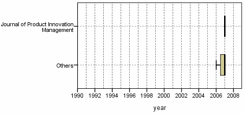4. Results
The sample showed that key-journals considered the academic spin-off theme important and reasonable for special attention. Several journals presented special issues about the theme in this decade; these journals are Research policy, Journal of Business Venturing, Research Policy, The Journal of Technology Transfer, Journal of Product Innovation Management, and Science Technology Industry (STI) of OECD. The Figure 2 presents the special issues titles, journal names and main discussed themes.
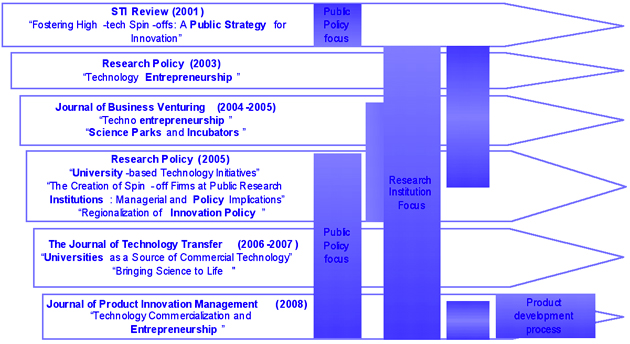
Figure 2 : special issue temporal sequence and main discussed themes
4.2 Temporal analysis of the documents
Several documents discuss the technological development through different emphasis: public policy, founding and basic research incentive laws, qualified human resource formation and absorption by companies, university-company cooperation, new technology-based company creation.
The academic search tool Google Scholar was used to identify publications with key-words “academic spin-off” (648 documents), “university spin-off” (1.420 documents), or “academic start-up” (64 documents), “academic startup” (8 documents), “university start up” (588 documents), “university startup” (215 documents), and “academic “spin-off”” (36.400 documents). The search was conducted from August 2007 to July 2008. An initial analysis was conducted to identify which of these documents denote some concern about academic spin-off management and performance.
This selection resulted in 85 publications from accessible databases, with theses, dissertations and papers from scientific journals. Publications like case studies and national panorama descriptions were avoided. The papers from scientific journals are distributed mainly in the following journals: Journal of Technology Transfer (16 papers), Research Policy (14 papers) and Journal of Business Venturing (seven papers). The contribution of journals is presented in Figure 3. It was named just journals that presented more than one document in the database and that were included in the Impact Factor evaluation in the Journal Citation Reports (JCR).
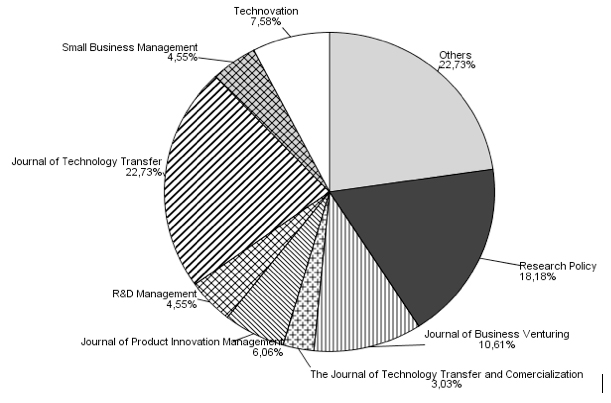
Figure 3 : Contribution of the main journals in the analysed database
Research lines grouping
The research lines were identified by cluster analysis. The documents were analyzed to evaluate the presence of the themes, using binary variables. The attribute presence was indicated by (1); and the absence, by (0). The documents were analyzed and grouped by its discussed theme similarities, by cluster analysis, using SPSS 13.0. As connection method, the ward method was used, considering that it enables spherical clusters with similar variances and sample sizes achievement without the linkage problem. The similarity measure used was squared Euclidian distance for binary data (SSPC Inc., 1997; Romesburg, 2004; Hair, et al., 2005).
For cluster number definition, the measure of cluster similarity in successive steps was analyzed. The definition point was identified as a significant decrease in the similarity measure progression (stopping rule) (Hair, et al., 2005). From this, ten clusters were obtained.
The documents clusters are described through the relative frequency of attributes in Table 1 . The lines represent the research lines (obtained clusters); and the columns, the evaluated themes. This relative frequency shows the theme occurrence in the total number of documents in the cluster. In each cluster the 100% appearance is stressed. The relative frequency of discussions in the total number of documents is also presented. The theme discussed by all components of the cluster was mainly considered for designation of the clusters.
The most discussed themes was: creation of academic spin-off (54% of all analyzed documents); spin-off environment (47%); and Research Institution Innovation System (42%). Other discussed themes are: technology transfer and spin-off (22%); and spin-off and competitive factor (19%). These themes were used for clusters’ names (research line) definition.
The management of spin-off companies theme is still a poorly discussed one (7%). It is highly discussed (100%) by Academic spin-off management with entrepreneurial team focus, moderately (40%) by Organizational Structure of Academic Spin-off, and very poorly (7%) by Environmental and research institute related factors and spin-off creation research line.
It is observed that the theme of new product development is a poorly discussed one (4%). It is presented just by the spread research line (14%) and Organizational Structure of Academic Spin-off research line (20%). This research line also discusses the related theme of decision making process (20%). This theme is only discussed by one more research line, the Academic spin-off management with entrepreneurial team focus (67%).
One knowledge area identified as contributing to the academic spin-off related academic discussions is the Evolutionary Perspective. This theme presented contributions to the following research lines: Competitive factor without Research Institution considerations (60%); Environmental and research institute related factors and spin-off creation research line (43%); and Organizational Structure of Academic Spin-off research line (40%).The research lines denomination and description are presented in Figure 4.
Research line (quantity) |
Description\example |
Environm - Academic S.O. environment without RI consideration (9) |
Presents discussion on academic spin-off environments. There is absence of discussion related to National or Institutional Innovation system. 60% discussed about spin-off creation. The least discussed themes were (20%) networking, (10%) Incubator and Technology Park entrepreneurial team, and competitive factor. |
Env&RI - Environmental and Research Institute related factors and spin-off creation (15) |
Discusses environmental factors affecting spin-offs, mainly spin-off creation (90%). The main factors are the Institutional Innovation System (80%), and National Innovation System. It is also discussed the aspects as networking (70%), entrepreneurial team, and spin-off management. |
SO_Creat - Academic Spin-off Creation (13) |
All works discuss the spin-off creation. However, this discussion is not related to technology transfer. The discussion is frequently (70%) centered in Institutional Innovation System and occasionally (20%) entrepreneurship, entrepreneurial team and networking |
SO_TTMec - Academic S.O. as a Tech. transference mechanism (6) |
Discusses using the technology transference focus, emphasizing (30%) incubator and technological park, spin-off development phases, and environmental factors. It is also discussed (20%) venture capital and investments, National innovation System or corporate spin-off. |
IS_Creat - Institutional Innovation System and Academic S.O. creation as Tech. Transf. Mechanism (8) |
This cluster discusses (100%) the Institutional Innovation System and its influence on spin-off creation as technology transferring process. The themes National Innovation Systems and spin-off typology are also (10%) discussed. |
RI_CompF - Research Institute environment as competitive factor for academic S.O. (8) |
Discuss the Institutional Innovation system and the spin-off environment as competitive factor for academic spin-off. It is also discussed: spin-off creation (60%); Evolutionary Perspective (40%); spin-off development stages (30%); and typology (30%). The themes venture capital; Incubator and Technological Park; networking; spin-off organizational structure and technology transference are less discussed. |
Compet_F - Competitive factor without RI consideration (5) |
There are discussed competitive factors focused on venture capital (60%); Evolutionary Perspective (60%), and spin-off creation (60%). None discusses the Research Institution. The themes typology and entrepreneurial team are less discussed. |
Enterpr_T - Academic S.O. management with entrepreneurial team focus (3) |
The focus of the theme spin-off management in this cluster is the entrepreneurial team. Frequently are discussed (70%) the themes decision making and entrepreneurship. There are also discussions with comparisons to corporative spin-off (30%). |
Org_Str - Organizational Structure of Academic spin-off (5) |
The Organizational structure of academic spin-off is discussed. The focus (80%) is that it acts as the success factor of the spin-off. There are observed significant discussion (40%) about academic spin-off management, entrepreneurial team, and spin-off environment. In 40% of the discussions, the Evolutionary Perspective was used. There are fewer discussions (20%) about Integrated Product Development Process and decision making. |
Spread cluster (12) |
This cluster is the most divergent in the discussed themes. The theme typology was discussed in the majority (60%). The spin-off environment was also discussed (40%). Fewer discussions were observed as related to corporate spin-off (20%), entrepreneurial team (10%), networking, competitive factor, Evolutionary Perspective, or spin-off creation. |
Figure 4 : Research line (document cluster) description
For better visualization of the research lines’ similarity, Table 2 was used to conduct the multidimensional scaling. This method graphically presents the dissimilarity measure as a distance between the research lines. The multidimensional scaling was conducted using Proxscal procedure of SPSS 13.0. The larger dimension number allows a better fit, but visualization can be lost. Hence, a three dimension plot was used. The measures of the obtained fit quality were: 0.05588 for S-Stress measure, and 0.1972 for normalized raw stress. The resultant coordinates were plotted and presented in Figure 4.
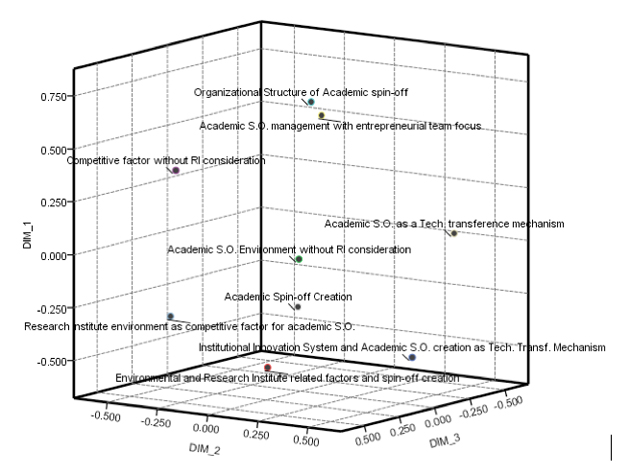
Figure 5 : Multidimensional scaling of obtained research lines
The obtained plot (Figure 5 ) complements Figure 4 , showing similarities between obtained research lines. Thus, it is evidenced that the research line Research Institute environment as competitive factor for academic spin-off and the research line Academic spin-off management with entrepreneurial team focus are the most distant from each other. It means that these two research lines are the most divergent ones. This is showed in Table 1 : in these two research lines, all themes discussed by one research line are not discussed by the other.
The most similar themes were presented by the research lines Environmental and Research Institute related factors and spin-off creation and Academic spin-off creation; the first and the Research Institute environment as competitive factor for academic spin-off; Environmental and Research Institute related factors… and Academic Spin-off environment without Research Institution consideration; and Academic spin-off creation and Institutional Innovation System and Academic Spin-off Creation as Technology transfer mechanism. The similarities of those pairs are evidenced by the common discussion of the themes (different frequencies).
The temporal evolution of the academic spin-off discussion
The clusters obtained in the previous section are the research lines identified to conduct the objectives of this work. Those research lines were evaluated considering the distribution of another variable of interest (year of publication). The spread research line was omitted because it has a heterogeneous theme. The Boxplot diagrams in Figure 6 present those distributions. The subsequent analysis was conducted considering the different amount of documents comprising the research lines.
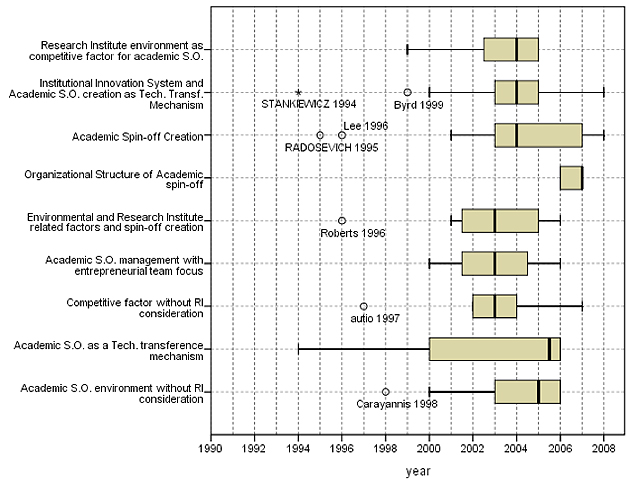
Figure 6 : Box plot with publications year distribution for research lines
The research line Institutional Innovation System and Academic Spin-off creation as Technology Transfer Mechanism shows that the quantity of publications per year is a little more concentrated in the period between 1997 and 2001.
The research line Academic Spin-off as a Technology transfer mechanism is a research line dispersed across a larger publication period than other research lines. Those publications occurred before 2006. It presents great dispersion on initial publication period, but is more concentrated between 2005 and 2006. It is shown that the spin-off creation as a technology transfer mechanism, even if it started in the early 90’s, was more emphatically discussed recently (more than 50 % of publications occurred in 2006).
The research line Academic spin-off environment without Research Institution consideration starts mainly in 2000, even though there was one outlier in 1998, the work from Carayanis et al. (1998). Therefore, this research line also presents a slight asymmetry to left, indicating growing attention to the environment theme more recently.
The research line Academic Spin-off Creation presents distribution with asymmetry to right. Most of the research lines start publishing in 2001. However, two outliers are observed in the middle of the 90’s (Lee, 1996; Radosevich, 1995). It indicates that even if the initial studies on this research line started in the middle 90’s, documents were more concentrated in the period between 2003 and 2004, and the works are kept being published until the end of the analyzed time, although with declining frequency through time.
The focus of this work, the research line Organizational Structure of Academic spin-off, presents an asymmetry to the left and its documents are more concentrated in recent times, between 2006 and 2007. It indicates that the research line is growing. The research lines discussed with reasonable emphasis in recent years are mainly Academic Spin-off Creation and Organizational Structure of Academic spin-off, although the former are diminishing and the latter are growing. The research line Organizational Structure of Academic spin-off is more recent than Research Institute environment as competitive factor for academic S.O. And most of the components (75% or more) of research lines Compet_F, Enterpr_T, EnvandRI, and IS_Creat are prior to Org_Str.
Contribution of the main journals on the Research Line
In this item, the boxplots generated by exploring the database grouping by journals and obtained research lines are analyzed. The theme Spin-off was studied by different views. The journals were analyzed as representing different knowledge areas discussing the macro-theme Spin-off by different views. Although the graphs presented progression from 1990, it is stressed that the all main journals analyzed were published only after 1995. They were considered journals that presented more than one document in the database and that were included in the Impact Factor evaluation in the Journal Citation Reports (JCR).
Initially, the journals were analyzed by the temporal evolution in according to the discussion groups. The Figure 7 presents the boxplots disposed by groups within journals. The figure also presents the summarized scopes of the journal, and if have academic discussion or practice approach.
The research lines were not present in all journals. The presence of research lines was consistent with the journal scope. For example, the Research Policy and Technovation present a macro scope, and the documents from lines with macro view of the spin-off are presented in these journals. Furthermore, the Journal of Product Innovation Management presented documents of lines with micro view.
It was observed that from all journals named, there were also some practice-focused journals presenting the macro-theme in more recent years. This can be understood as an indicative of maturity of this macro-theme, growing from academic and theoretical discussion towards a practical discussion.
Research Policy |
Approach: Academic Scope: Entrepreneurship, Evolutionary Economics, Industrial Clusters, Innovation Management/ Policy, System of Innovation, Product and Process Development, R&D Management, Research Policy |
|
Technovation |
Approach: Academic Scope: Management of entrepreneurial ventures, management of innovation, organizational structures, the innovator, and technology transfer to developing nations |
|
Journal of Business Venturing |
Approach: Practice Scope: Practice of entrepreneurs, innovators, and their support systems; |
|
Journal of Technology Transfer |
Approach: Practice Scope: Management practices and strategies toward technology transfer, public policy developments, regulatory and legal issues, and global trends |
|
R&D Management |
Approach: Academic Scope: Full range of topics in research, development, design and innovation, and related strategic and human resource issues |
|
Journal of Product Innovation Management |
Approach: Academic and Practice Scope: Academic theory and effective management practice for both the internal and external environment of the organization |
|
Figure 7 : Journals and temporal distribution of research lines
Following, the obtained lines were also described according to the publishing journal. The Figure 8 detaches two of these groups.
Academic Spin-off creation |
|
Organizational Structure of Academic Spin-off |
|
Figure 8 : some lines of interest and journals that contributed to this line
It is observed that the Academic Spin-off creation macro-theme was initially discussed by policy and National Innovation System view, as demonstrated by the fact that from 1996 to 2004 it was discussed by the journal Research Policy (macro view). Subsequently presents focus in discuss the technology transfer process, new venture generation, as presented by the documents observed from Small Business Management, Journal of Technology Transfer and Journal of Business Venturing. These focuses, as shown by the evaluation of journals main approaches and scope, were more worried about practice inside the Research Institutions and Companies. At last, it was observed a document from the Journal of Product Innovation Management, a journal focused both in practice and in academic discussion, but in essence presents more micro view.
The line Organizational Structure of Academic Spin-off was discussed recently, as presented previously. The Figure 8 shows that this line was composed by documents from different journals, and among the main elected journals, it was presented in the Journal of Product Innovation Management, one journal that focus on the managerial aspects of the Product Development and Innovation Process inside the company.







